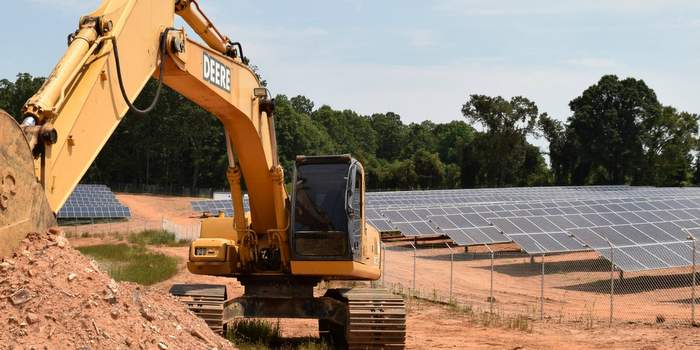In any scenario, the construction phase of a solar energy project brings with it a slew of logistical challenges and decision points for the delivery team. During the COVID-19 crisis, that list has understandably grown. COVID-19 has impacted all aspects of construction, both administrative and in the field. Where solar construction activities have been allowed to continue, thinking about and planning for procurement, permits and interconnection, host considerations, construction on site, and commissioning are all key to minimizing project delays.
Below are a few considerations to keep in mind during COVID-19 to help maintain schedules while implementing protocols that minimize safety risks for those involved. Note that this list of considerations is non-exhaustive, but it provides some of the most pertinent concerns the Sol Systems team looks to address.
Procuring equipment
Procurement can be a challenge because once a purchase order is issued, there is not much a buyer can control. Despite needs and changes that arise on the developers’ end, manufacturers almost always run on their own schedules. However, the buyer (in most cases the contractor building the PV system) can ask several questions to better understand timing for material delivery. There are two important questions to ask of manufacturers.
1. Where is the material coming from?
2. At what capacity are plants running?
Responses to these key questions will provide the buyer with a sense of expectations for delivery. Material coming from overseas raises a red flag, as it may not be allowed to enter the Unites States. If plants are only operational at a certain percentage, the plant may be backlogged and material delays may be expected. The manufacturer should provide expected timelines for deliveries and provide feedback when delays are expected, but it is the responsibility of the buyer to check in on these constantly to adjust plans and have alternatives if delays are expected.
Utilities and AHJs
COVID-19 has caused a great deal of uncertainty around Authorities Having Jurisdiction (AHJs), the county or local offices that review and approve designs/applications for project permits, and utilities.
States and localities have approached COVID-19 in varying forms: reduced hours, reduced personnel, or closures. It is the contractor’s responsibility to know if the local AHJ is operational. If so, at what capacity is the AHJ operating? The AHJ’s availability will determine if permit applications will be reviewed and approved in a timely manner, therefore maintaining the project schedule.
As projects near completion, AHJ inspections are required. Are inspectors willing to go on site and if so, are there special considerations for in-person visits like safety masks and gloves, requirement for reduced personnel on site, restricted times and dates for visits? A project cannot close until the project receives the final sign-off from the AHJ inspector. Contractors must accommodate these needs.
Utility considerations are similar. Utilities remain operational because they are essential businesses, but COVID-19 may be affecting their solar operations. Are they allowing teams to go on site for system interconnections, witness testing, and installation of net metering (where applicable), or are restrictions in place? An interconnection, especially at a facility that operates full time, requires coordination between multiple parties. Understanding where the utility stands on this topic will minimize delays. Lastly, how does an interconnection or meter swap scope differ for activities inside buildings versus outside? It is the contractor’s responsibility to ask these questions in advance and prepare.
Hosts
Another important consideration is the system host. Whether the PV system is a ground mount, a canopy, or a rooftop, the contractor must understand the host’s requirements. Is the host allowing construction at its site? If the host is allowing construction, has that party issued special considerations or protocols to take while on site? For example, they may require temperature checks and sanitizing stations, limiting the number of construction employees allowed on site, and limiting or restricting deliveries to the site.
These protocols impact construction activities and contractors must find ways to accommodate these into the schedule. A limitation on the number of deliveries allowed on site may require an adjustment in the sequence of activities. Close communication with the host to coordinate these activities is essential to project success.
Construction
Understanding the external variables around construction is only a part of the planning phase. Once the construction team is ready to go on site or resume its activities, there are several considerations to take into account. Are there activities that require close contact with others, for example module installation and racking torqueing? If so, how should these activities be treated to ensure everyone’s safety?
The contractor should consider taking additional safety precautions such as morning and evening safety check-ins, staggering lunches, requiring the use of masks and gloves, requiring each employee to have and use its own tools, and requiring each employee to clean machinery like lulls and cranes after each use. Nothing should come before the safety of workers.
Commissioning and testing
The last phase of construction is commissioning and testing. While some contractors perform this in-house, others require third parties to perform testing. If so, is the preferred testing company willing to have their employees travel to the site? These same questions are applicable for manufacturer commissioning. Are there company travel restrictions preventing or delaying personnel from performing these activities? The contractor must consider how this impacts the schedule and plan for alternatives, like hiring a certified third-party commissioner who is available and willing to travel to the site.
In these uncertain times, solar energy contractors are responsible for ensuring the safety of their teams and all those who visit their project sites, while maintaining the agreed upon construction schedule and adhering to host, utility, and AHJ requirements. Clear communication, attention to detail, proper precautions, and keeping up with evolving health recommendations can ensure clean energy is put into the ground today safely and successfully.
Sintia Torres is DG Project Manager for Sol Systems.
— Solar Builder magazine

 and Choice
and Choice
Leave a Reply
You must be logged in to post a comment.